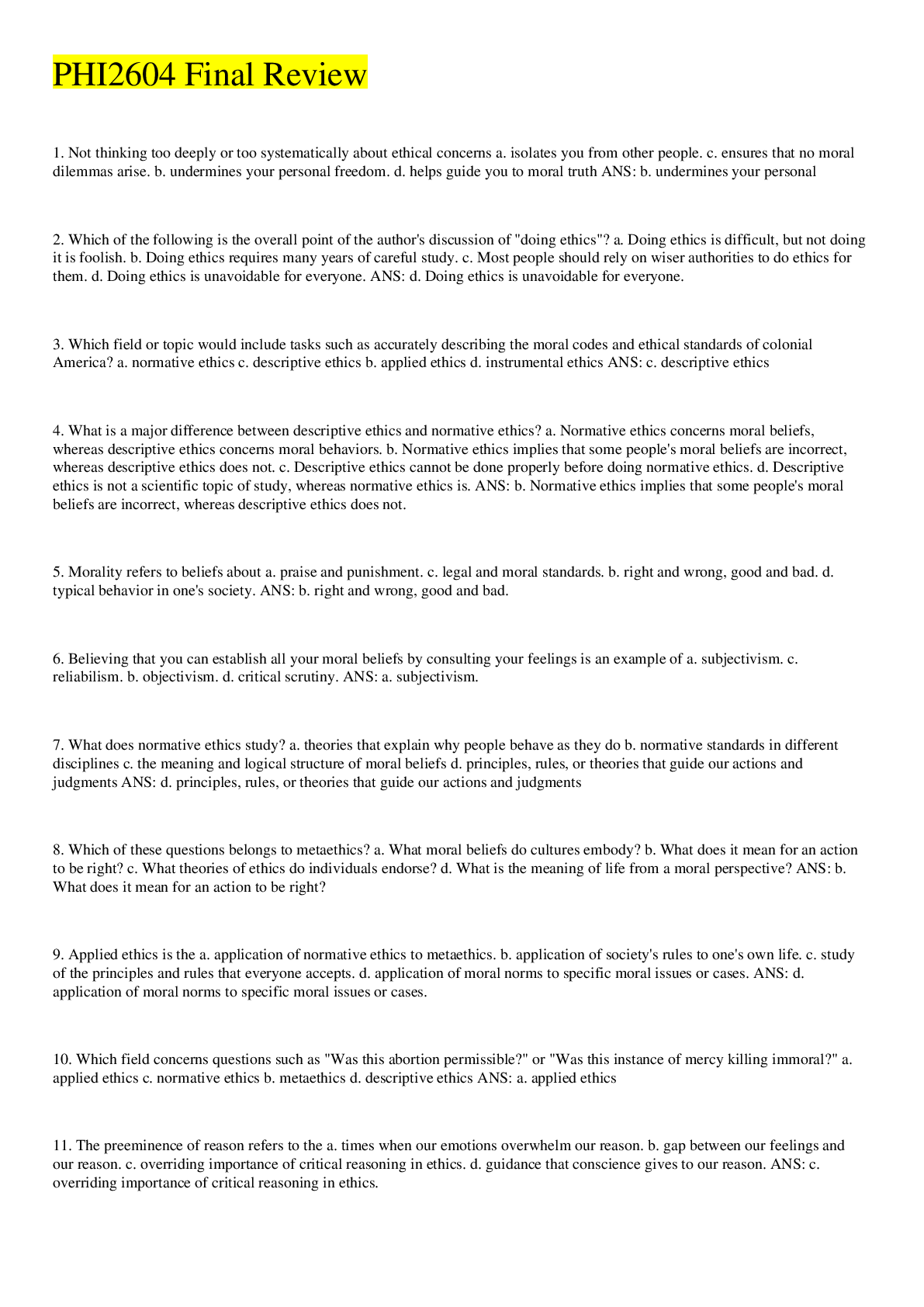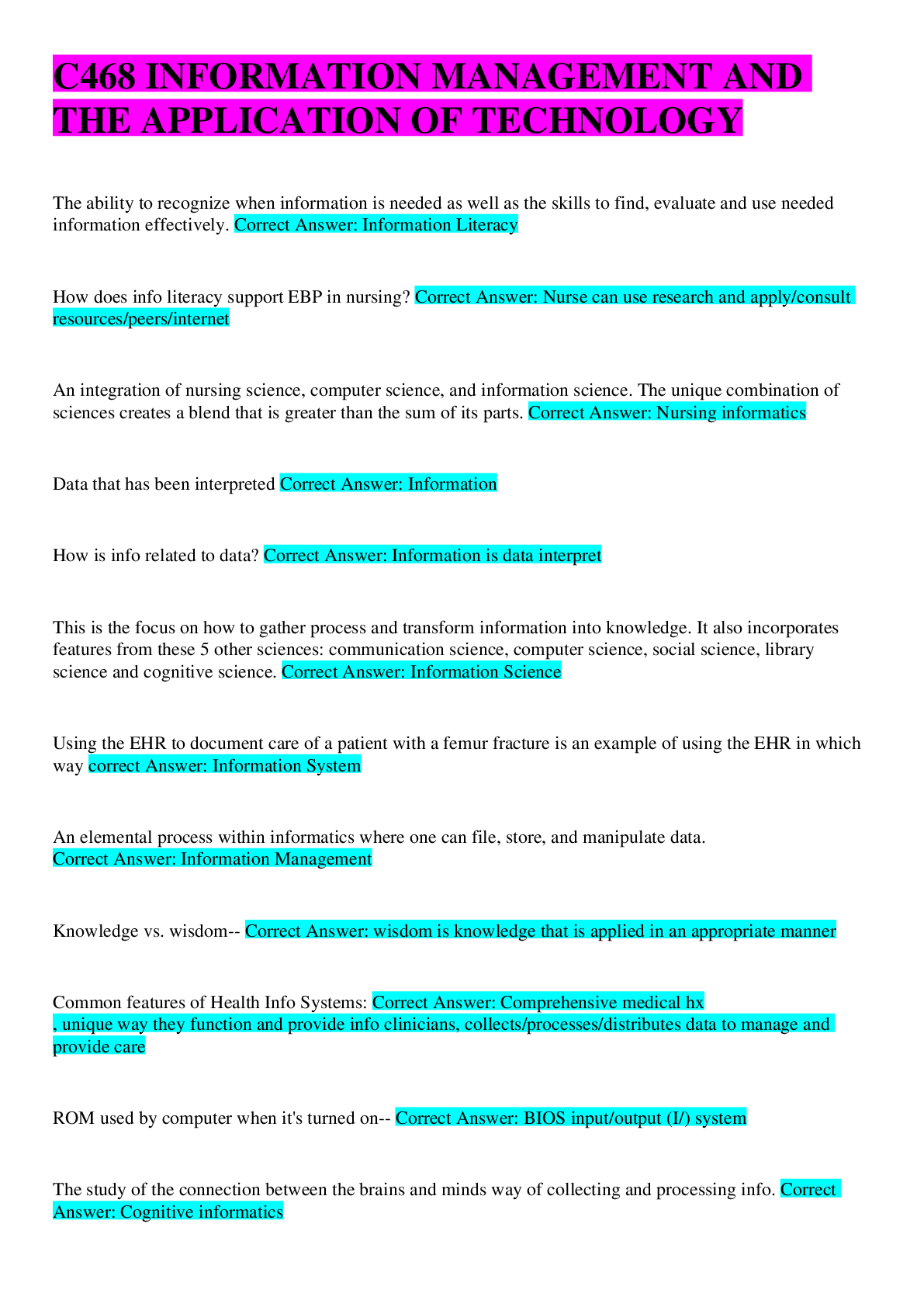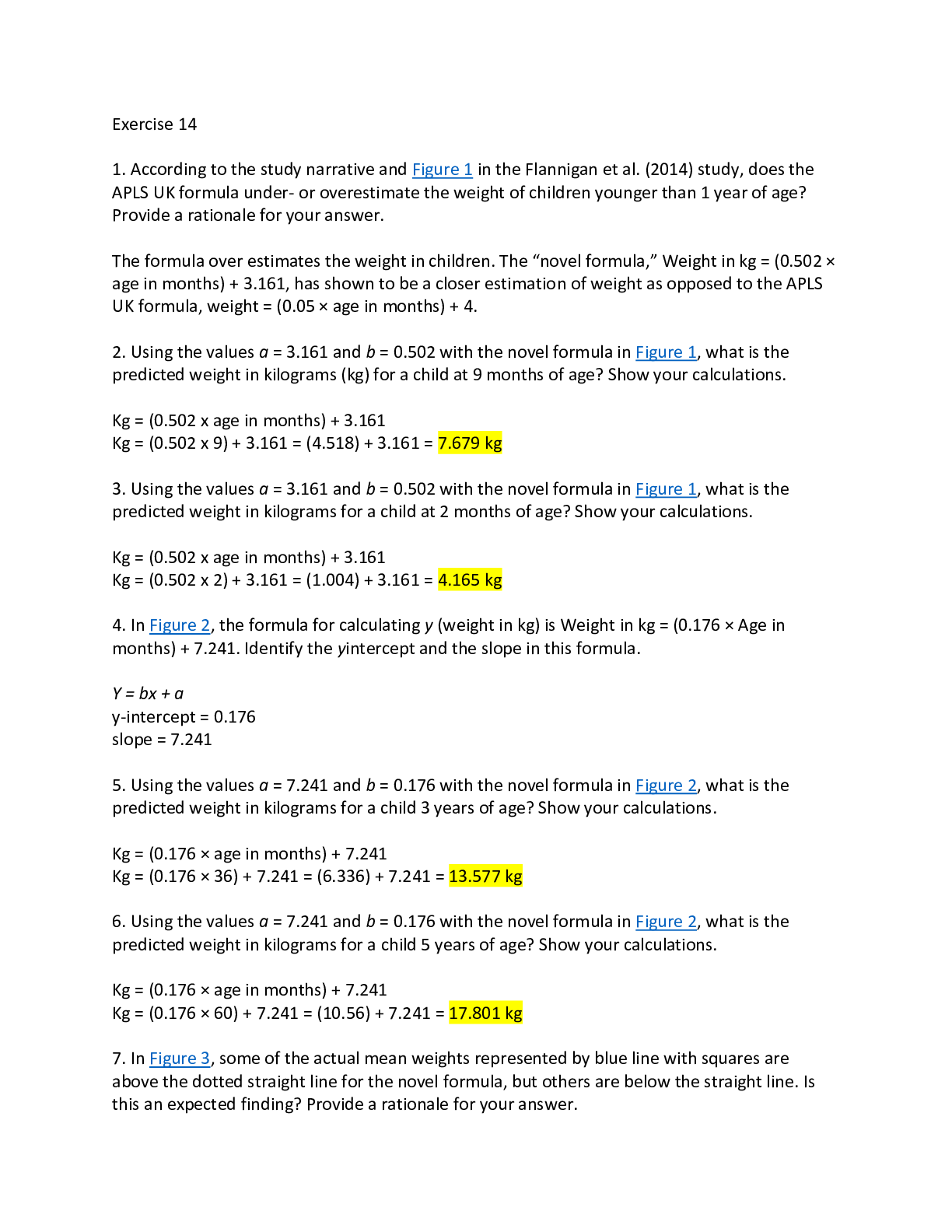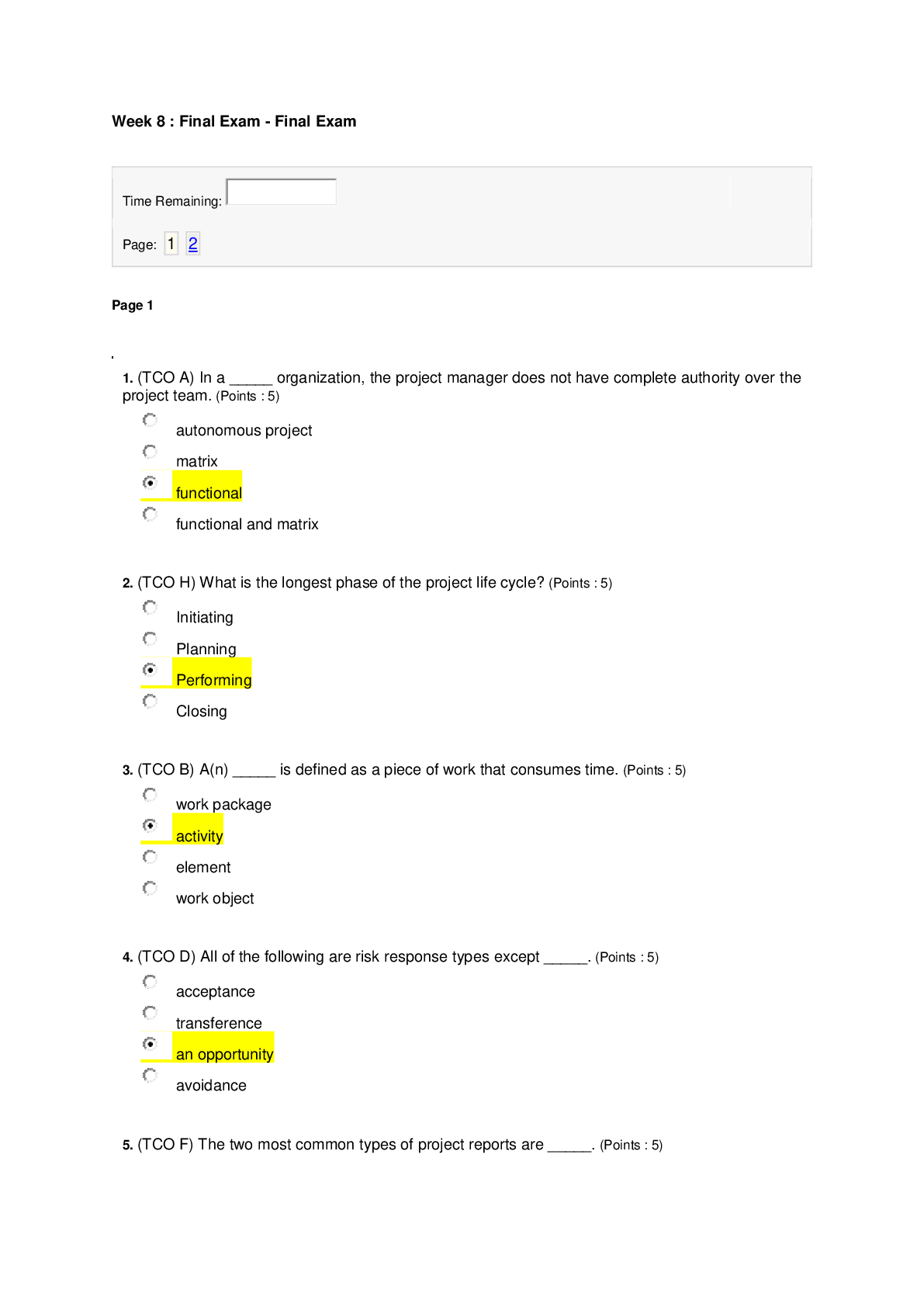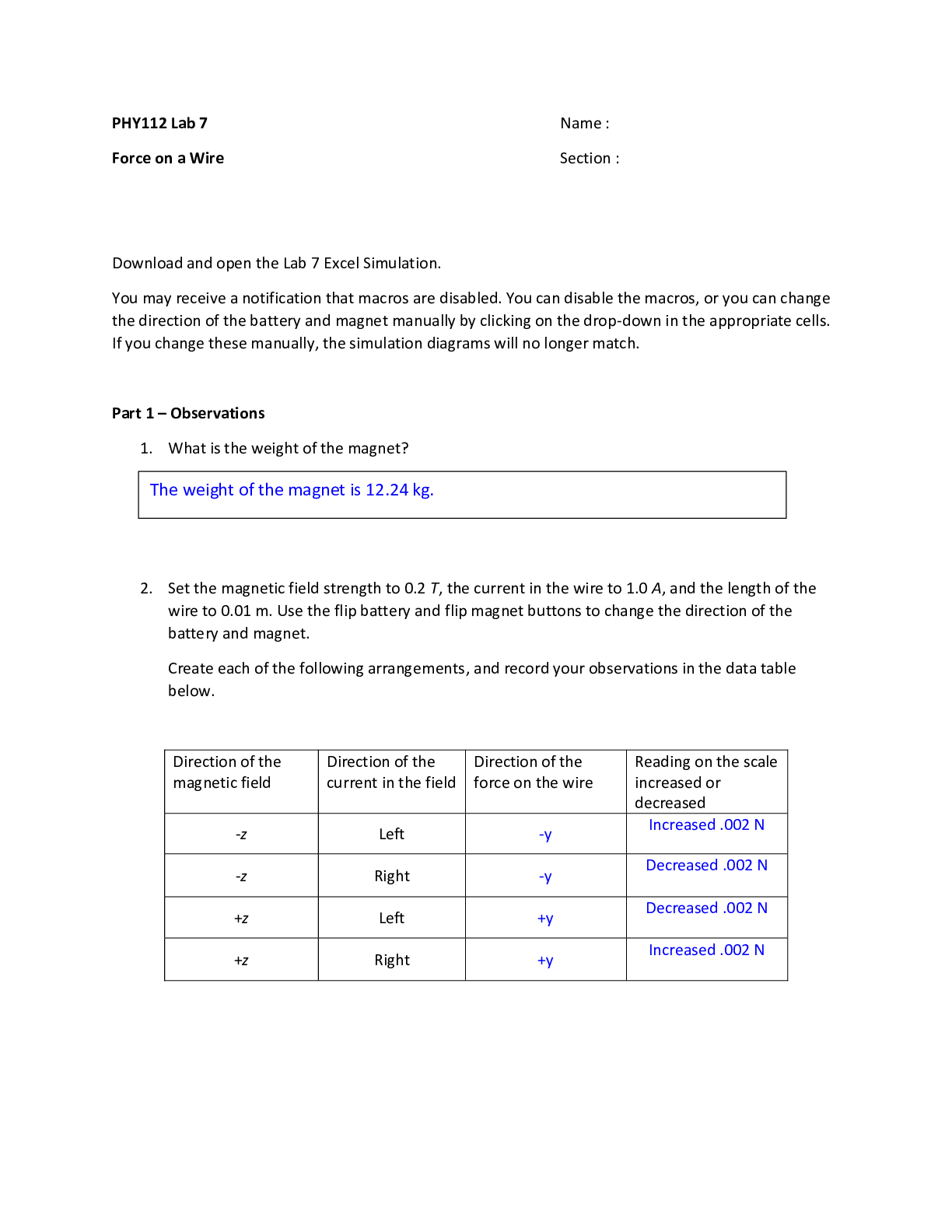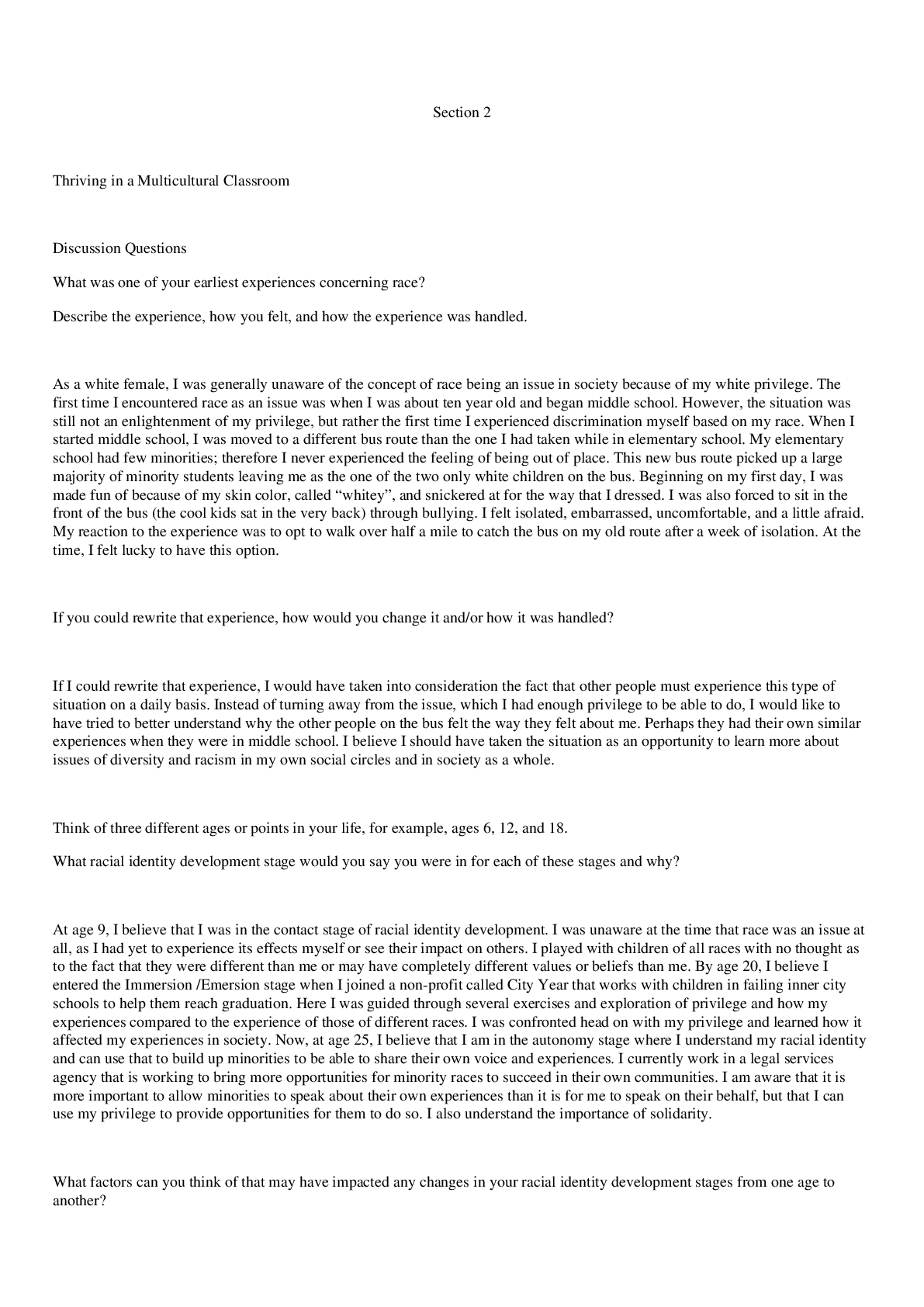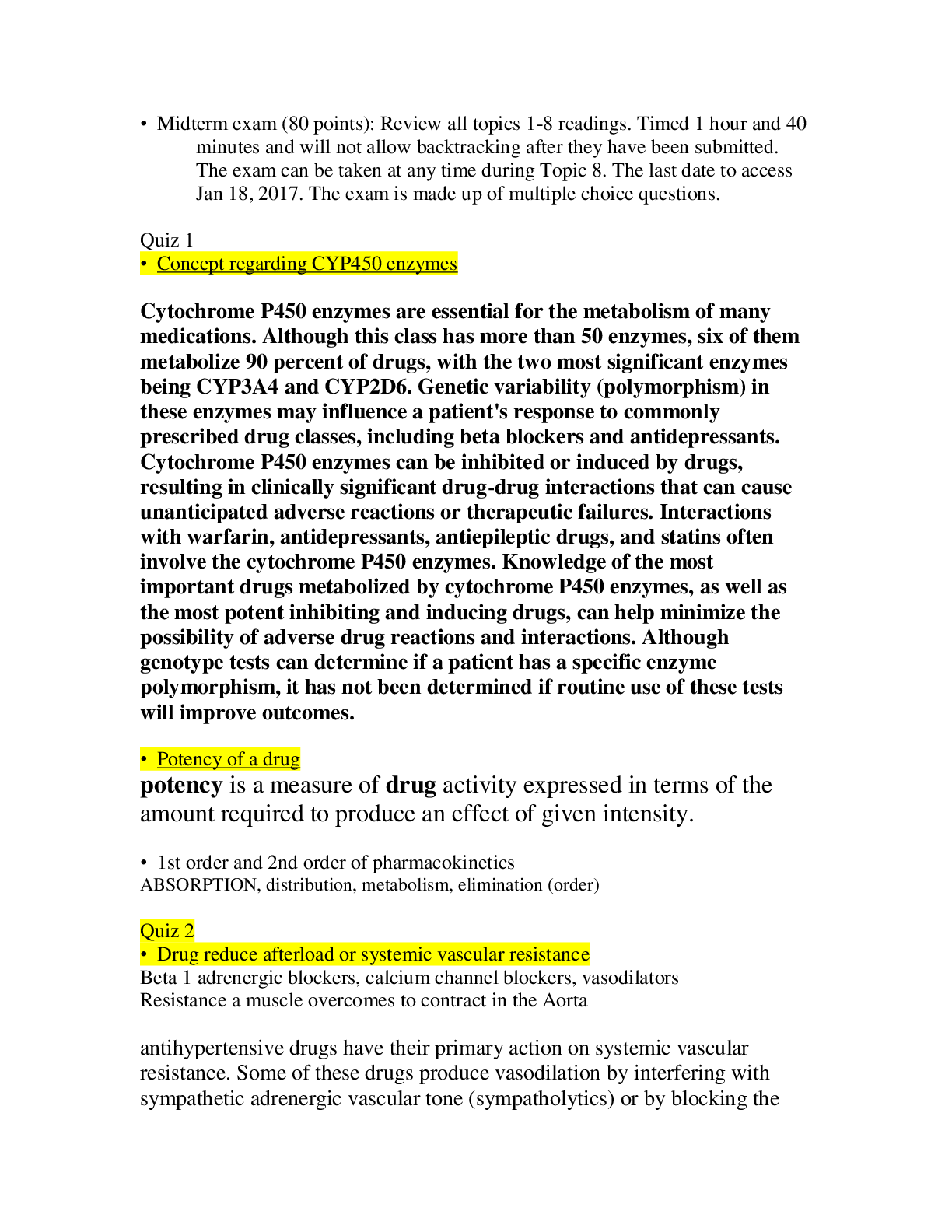Biology > STUDY GUIDE > Med-Surg ATI Neurosensory Quiz (All)
Med-Surg ATI Neurosensory Quiz
Document Content and Description Below
A nrse perfoms a neurologic assessment on a client with a brain tumor. Which of the following findings should indicate to the nrse cranial nerve involvement? A: Dysphagia B: Positive Babinski sign... C: Decreased deep tendon reflexes D: Ataxia Correct answer- A: Dysphagia (difficulty swallowing may occur as a result of the cranial nerves IX -glossopharyngeal & V -vagus nerve.) A nrse is assessing a client who was just admitted to the hospital for observation following a closed-head injury. Which of the following is the most essential nursing assessment to detect early signs of a worsening condition? A: Vital signs B: Body posture C: LOC D: Focal neurological exam Correct answer- C: LOC A bolus of mannitol (Osmitrol) is ordered for a client with a closed-head injury showing manifestations of increasing intracranial pressure. Prior to administration, assessment shows: UO 40 mL/hr, apical HR 88/min, and the pupils equal and reactive. The client is sleepy but easily aroused. After administering mannitol to the client, which of the following should indicate to the nrse that the medication is having the desired effect? A: UO is 100 mL/hr B: Pupils are dilated C: HR is 62/min D: Client is difficult to rouse Correct answer- A: UO is 100 mL/hr (osmotic diuretic used to ↑ UO and ↓ cerebral edema) A nrse is caring for a client who is post-op following a craniotomy to evacuate a subdural hematoma. The nrse notes the client's UO is greater each hour than the previous hour; from 1800 to 1900 the UO was 200 mL, from 1900 to 2000 the UO was 400 mL, and from 2000 to 2100 the UO was 600 mL. The nrse informs the surgeon and anticipates that the lab value that will be prescribed at this time is: A: Blood Urea Nitrogen B: Blood sugar C: Urine ketones D: Specific gravity Correct answer- D: Specific gravity A nrse is reading the results of a lumbar puncture (LP) performed on a client suspected of having bacterial meningitis. Which of the following findings should the nrse recognize as being consistent with this diagnosis? A: Elevated glucose B: Elevated protein C: Presence of RBC D: Presence of D-dimer Correct answer- B: Elevated protein (typically CSF has a higher proportion of glucose than protein, an elevated protein is consistent with meningitis) A client has been diagnosed with acute angle closure glaucoma. The nrse should expect the client to report A: Showers of floaters B: Flashes of light across the eye C: Eye pain and blurred vision D: Double vision Correct answer- C: Eye pain and blurred vision Which of the following statements, made by a client who had an IOL implant this morning, should indicate to a nrse a proper understanding of discharge instructions? A: I will sleep in my recliner tonight. B: I will avoid bending over or coughing. C: I will follow a low-salt and caffeine restricted diet. D: I will report any signs of photophobia to my Dr. Correct answer- B: I will avoid bending over or coughing. A nrse is caring for a client with Guillain-Barre syndrome. Upon assessment, the nrse should anticipate that the client will exhibit which of the following? A: Tonic-clonic seizures B: Complaints of a severe headache and nausea C: Weakness of the lower extremities D: Decreased level of consciousness Correct answer- C: Weakness of the lower extremities. A nrse understands that a client with a seizure disorder, who frequently experiences an aura is describing a: A: Sensory warning that a seizure is imminent. B: Continuous seizure state in which seizures occur in rapid succession. C: Period of sleepiness following the seizure, during which arousal is difficult. D: Brief loss of consciousness accompanied by staring. Correct answer- A: Sensory warning that a seizure is imminent. (client may report hearing bells, seeing lights or smelling something) A client has undergone surgical repair via scleral buckling of a detached retina of the left eye with an injection of a gas bubble. The nrse should anticipate that the surgeon will prescribe the client to assume which postoperative position? A: Semi-fowler's position while wearing shaded dilation glasses B: Prone position with operated eye up. C: Left lateral position with the eye shield on the left eye. D: Trendelnburg position without a pillow. Correct answer- B: Prone position with operated eye up. In which of the following positions should a nrse place a client following a craniotomy for evacuation of a subdural hematoma of the frontal lobe? A: Supine B: Prone C: Semi-fowlers D: Sims Correct answer- C: Semi-fowlers (head midline and the HOB elevated 30, allowing blood flow to the brain while allowing venous drainage, ↓ risk of IOP) A nrse is assessing a client who is reporting a sore throat, pressure in the ear, decreased hearing, and mild dizziness. The client has been treating himself for a cold for 1 week. The nusre should expect an alteration of which of the following structures? A: The temporomandibular joint B: The inner ear C: The external ear D: The middle ear Correct answer- D: The middle ear A nrse is educating a client who was just dianosed with open angle glaucoma about the condition. Which of the following information should the nrse include in the teaching? (Select all that apply) A: Do not take cold medications that contain pseudoephedrine. B: Expect impaired night vision. C: Glasses will be necessary to correct the accompanying presbyopia. D: Driving may be dangerous due to loss of peripheral vision. E: Laser surgery can help reestablish the flow of aqueous humor. Correct answer- A: Do not take cold medications that contain pseudoephedrine. B: Expect impaired night vision. D: Driving may be dangerous due to loss of peripheral vision. E: Laser surgery can help reestablish the flow of aqueous humor. A client with Meniere's disease is hospitalized for recurring episodes caused by the disease. The nrse should anticipate documenting which of the following measures to help prevent exacerbation of the disease in the client's plan of care? A: Avoid bearing down (valsalva maneuver) B: Increase fluid intake C: Avoid sudden movements D: Increase sodium intake Correct answer- C: Avoid sudden movements A nrse is talking to a client's spouse about degenerative complications associated with Parkinson's disease. The highest priority topic for the nrse to talk to the spouse about is the risk for: A: Aspiration B: Emotional lability C: Impaired speech D: Self-care dependency Correct answer- A: Aspiration (priority because it could lead to choking) A nrse explains to a family of a client recently diagnosed with amyotrophic lateral sclerosis (ALS) that early manifestations typically include: A: Sensory dysfunction B: Weakness of the distal extremities C: Decreased cognitive functioning D: Altered temperature regulation Correct answer- B: Weakness of the distal extremities A nrse in a clinic is providing teaching to an adolescent client who has been diagnosed with swimmer's ear, or external otitis for the 3rd time in 2 months. The nrse should instruct the client to: A: dry the ear with a cotton swab after swimming. B: Instill hydrogen peroxide into the ear after swimming. C: Instill diluted alcohol into the ear after swimming. D: Dry the ear with a twisted paper towel wick after swimming. Correct answer- C: Instill diluted alcohol into the ear after swimming. A nrse is caring for a client who was admitted secondary to transient ischemic attacks (TIA). The goal of therapy for the client is: A: Reversal of disability B: Reduction of cerebral bleeding C: Reduction in cerebral edema D: Prevention of a cerebrovascular accident. Correct answer- D: Prevention of a cerebrovascular accident When assessing a client who reports mastoiditis, it is best for the nrse to use which of the following techniques? A: Palpation B: Inspection C: Ototscopic examination D: The weber test Correct answer- A: Palpation A nrse is assessing an unconscious client. The nrse notes that the client has a rhythmical breathing pattern of increasing depth and a rate alternating with periods of apnea. The nrse should document that the client is having: A: Ataxic respirations B: Cheyne-Stokes respirations C: Apneustic respirations D: Kussmaul respirations Correct answer- B: Cheyne-Stokes respirations An unconscious client assumes a decerebrate position in response to any noxious stimuli. When drawing a blood sample, the nrse should expect the client to: A: Rigidly extend all four extremities. B: Internally flex the arms and extend the legs. C: Tightly curl into a fetal positon. D: Internally rotate the arms and legs. Correct answer- A: Rigidly extend all four extremities. A client is transferred to a rehab center 3 weeks following a cerebrovascular accident (CVA). The client's CVA involved the left side of the brain. Which of the following goals should the nrse anticipate including in the client's rehabilitation program? A: Improving left-side motor function B: Establishing the ability to communicate effectively C: Learning to control impulsive behavior. D: Keeping the left side of the body safe. Correct answer- B: Establishing the ability to communicate effectively. A nrse is caring for a client who has sustained a high thoracic spinal cord injury following a diving accident. The nrse suspects that the client may be experiencing the complication of autonomic dysreflexia when the client exhibits: A: Rhinorrhea B: Hypotension C: Tachycardia D: A severe headache Correct answer- D: A severe headache A client with a seizure disorder is being discharged. The client's family has many questions about what to do if the client has a seizure while at home. The nrse tells the family members that the first action to take in the events of a seizure is to: A: Support and protect the client's head. B: Ease the client to the floor if standing or seated. C: Loosen constrictive clothing. D: Turn the client on his side. Correct answer- B: Ease the client to the floor if standing or seated. A nrse is admitting a female client to have surgery to repair an unruptured arteriovenous malformation (AVM). The AVM was discovered after the client reported recurrent headaches and MRI was completed. Which of the following factors is helpful in regard to the nrse anticipating the client's other neurological manifestations? A: Baseline visual acuity B: Age of the client C: Duration of the manifestations D: Location of the AVM Correct answer- D: Location of the AVM A client with myopia asks the nrse about the possibility of LASIK surgery. The nrse tells the client that which of the following is a commonly experienced side effect following LASIK surgery? A: Eyelid tics and twitching B: Photosensitivity C: Excessive tearing [Show More]
Last updated: 2 years ago
Preview 1 out of 9 pages
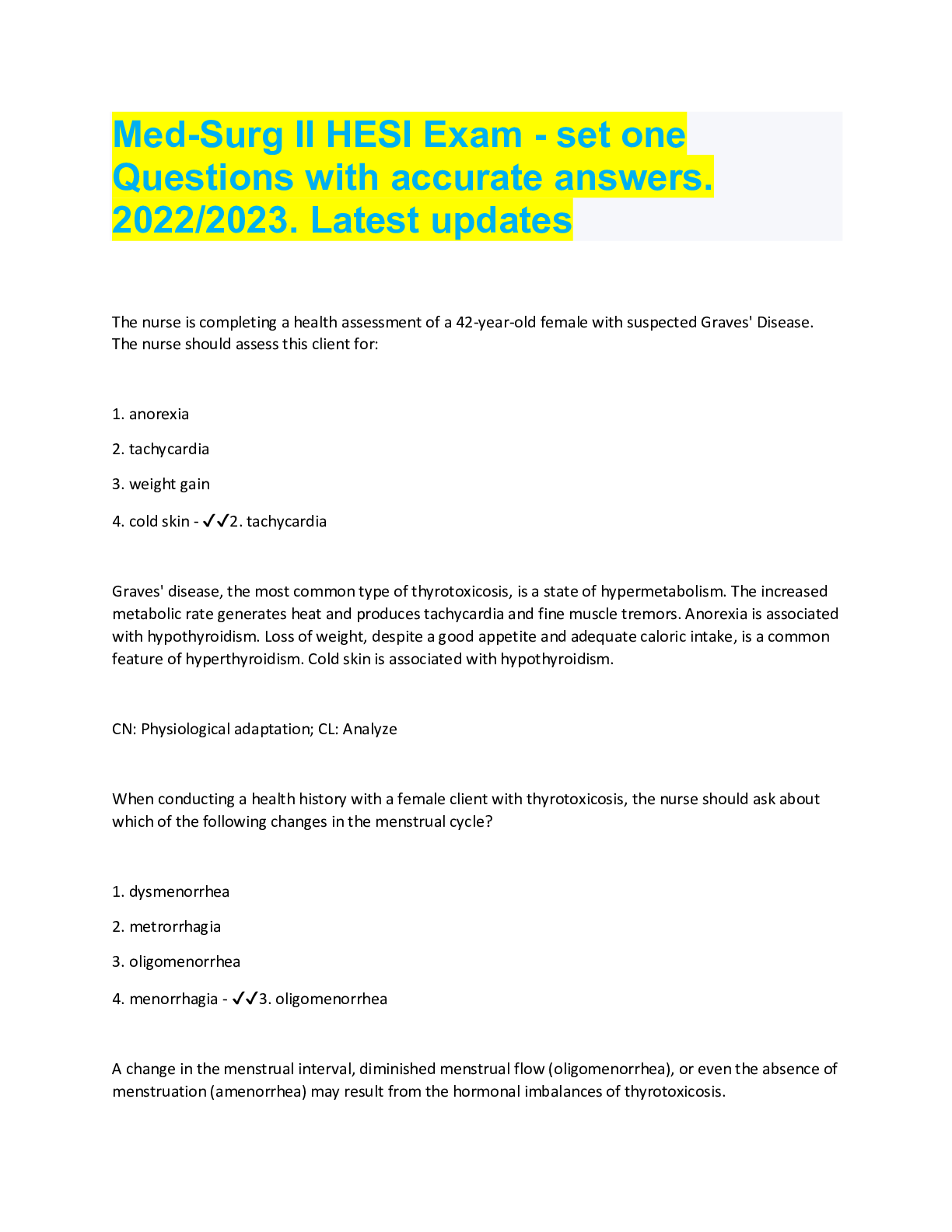
Buy this document to get the full access instantly
Instant Download Access after purchase
Buy NowInstant download
We Accept:

Reviews( 0 )
$14.00
Can't find what you want? Try our AI powered Search
Document information
Connected school, study & course
About the document
Uploaded On
May 15, 2022
Number of pages
9
Written in
Additional information
This document has been written for:
Uploaded
May 15, 2022
Downloads
0
Views
166




